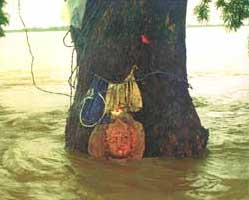Disastrous state
 For more than a decade now, Orissa has been reeling under contrasting extreme weather conditions: from heat waves to cyclones; from droughts to floods. Calamities have been visiting the state with alarming regularity. Out of the last 100 years, the state has been dis-aster- affected for 90 years: floods have occurred for 49 years, droughts for 30 and cyclones have hit the state for 11 years. Since 1965, calamities are not only becoming more frequent but strik-ing areas that never had a vulnerability record. For instance, a heat wave in 1998 killed around 1,500 people. Most of the casualties were in coastal Orissa, a region otherwise known for its mode-rate temperature.
For more than a decade now, Orissa has been reeling under contrasting extreme weather conditions: from heat waves to cyclones; from droughts to floods. Calamities have been visiting the state with alarming regularity. Out of the last 100 years, the state has been dis-aster- affected for 90 years: floods have occurred for 49 years, droughts for 30 and cyclones have hit the state for 11 years. Since 1965, calamities are not only becoming more frequent but strik-ing areas that never had a vulnerability record. For instance, a heat wave in 1998 killed around 1,500 people. Most of the casualties were in coastal Orissa, a region otherwise known for its mode-rate temperature.
The 1999 super cyclone spread to places like Bhubaneswar and Nayagarh that were never known to be cyclone-prone. While the 2001 drought parched the fields in coastal districts, the un-precedented flood of 2001 submerged 25 of the state's 30 districts. Many of these areas had never witnessed a flood before.
Why is this happening? Is there an emerging pattern in this cycle of des-truction? There is evidence that suggests that the state's ecology and weather conditions have undergone a change. Experts believe Orissa might well be showing up the impact of climate change induced by global warming. Although, the geographical location of the state is one of the causes behind these extreme weather influences, there is also a growing belief now that these natural calamities are not as natural as they apparently appear and that the state's environmental degradation has gone a long way in triggering these disasters. Today, 52 per cent of the state's land faces erosion due to defore-station. With mangrove forests being cleared, more and more areas have come under the grip of cyclones. Rivers deluge more areas due to siltation. When the government releases water in dams like Hirakud during the flood, this adds to the problem. Almost 490,000 ha of fertile lands have been waterlogged, salinated and sandcasted in the coastal Orissa due to cyclones and floods.
In the last four years, calamities have claimed more than 30,000 lives. Agricul-tural lands have become fallow and this has led to hunger and starvation deaths.
Caught in the cycle of disasters and impoverishment, the poor in Orissa have become even more vulnerable. Years of official neglect and mismanage-ment of natural resources have left them few options. The already stressed eco-system is made even more fragile with each disaster. And the poor living on the margins of subsistence are forced into greater penury. Worse, they are fast los-ing their capacity to rebuild their lives after each disaster. Consecutive calami-ties have ripped Orissa's economy apart. The devastating flood this year has already induced crop failure worth a whopping Rs 1,500 crore.
Against this deplorable backdrop and the permeating impact of the calamities, the state administration remains unruffled. Orissa's chief minis-ter Naveen Patnaik maintains, "Orissa is endemic to calamities and depressions in Bay of Bengal can't be whisked away.' Recently, when poverty-stricken people of Kashipur died after consuming the poisonous gruel made of mango kernels, Patnaik parroted lines like, "I under-stand that mango kernel consumption is common in that area', and "these are not hunger deaths, these are accidents and you cannot prevent accidents'. For the people of Orissa it is a circus of death with a misguided ringmaster.
Related Content
- State of the cryosphere 2023: two degrees is too high
- State of the cryosphere 2022: growing losses, global impacts
- A report titled 'Environmental assessment of tourism in the Indian Himalayan region' by GBNIHE, submitted to MoEF&CC, 03/06/2022
- Order of the National Green Tribunal on the Draft Development Plan, 2041, Himachal Pradesh, 12/05/2022
- 2021 disasters in numbers
- Order of the Supreme Court regarding holding of Rath Yatra in Puri, Odisha, 22/06/2020
